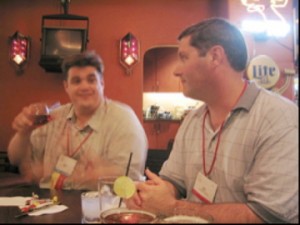THE BEER EFFECT OR THE VALUE OF FACE TO FACE INTERACTION
/This post is more to stimulate comment and examples than to tell you something you don’t already know: It’s easier to ask for help if you’ve had a beer/lunch/glass of wine with someone. Likewise, you’re more likely to provide help if you’ve had that food or beverage experience. (Photo by statico)
This post is more to stimulate comment and examples than to tell you something you don’t already know: It’s easier to ask for help if you’ve had a beer/lunch/glass of wine with someone. Likewise, you’re more likely to provide help if you’ve had that food or beverage experience. (Photo by statico) 
The example I generally provide in class comes from a combination of experiences with world-class technology companies. These firms do a wonderful job of supporting their engineers, especially through communities of practice. In all my example cases, these communities have some face to face interaction – even though travel budgets are tight. In the latest “heydays” of the Silicon Valley these face to face events would also include on-site dinners… yes, with beer. The engineers would mingle, drink beer, and share stories about how they had resolved problems. All the participants were experts and these discussions were far ranging. Knowledge was shared from around the firms’ global settings.
Perhaps more important than the knowledge shared at the moment were the relationships that developed. Everyone left the session knowing more people than when they arrived. In some cases they might have known of the people they were talking to, but they weren’t always acquainted with them. When everyone went home is when the “beer effect” took place. An engineer would need help. All these organizations have ample technical tools for linking engineers that need help with those who are most likely to have the answer (portals, mailing lists, expert knowledge bases) – but often it’s an issue of getting the expert to respond. What the participants discovered is that it was a lot easier to get a response from someone they had met (i.e., had a beer with). The benefits were huge and the time-savings immense. The beer costs were relatively low.
Times changed. The communities of practice still meet, but at two of the firms the dinners are now informal events where the participants just link up with a few others and go out to dinner. The costs of the meals are still borne by the firms, but the firms are not controlling or supporting mingling among people who do not already know one another. The reports I get are that people go out to dinner with people who are similar to themselves (come from the same location, are in another group together). (This “birds of a feather flock together” effect is so prevalent it has its own term in academic- speak “homophily.”) As a result, people leave the sessions knowing a few more people than they did before, but not as many as they might have and apparently not with the same level of relationship. No beer effect, less ability to call and receive help when needed.
This result highlights a common theme in this blog – for technology systems to provide value in organizations they must be intertwined with human systems. The high-quality portals and knowledge management systems that these organizations provide have greater value the greater the human relationships. The formal communities of practice are a foundation to this process, but may not be enough given human nature. Broader human relationships will amplify the value of the technology and organizational practices. When the dinners were part of the larger group there was a greater likelihood that people would develop relationships with different colleagues – rather than solidifying those they already had -- there might have been an empty place at a table, people might meet in the dinner line.
Organizers don’t need to have the big dinner with a flowing keg. Small, off-site dinners can work, but the groupings need to be proactively managed (another recurring theme in this blog (e.g., here and here).
What specific examples have you seen work well? This seems to be a situation for explicitly expanding social networks. Rob Cross describes a large meeting where the participants wore RFID name tags that glowed when people who the technology system thought should meet came close to one another. Sounds great, and I’d love to try it, but are there other approaches that are easier to implement?







